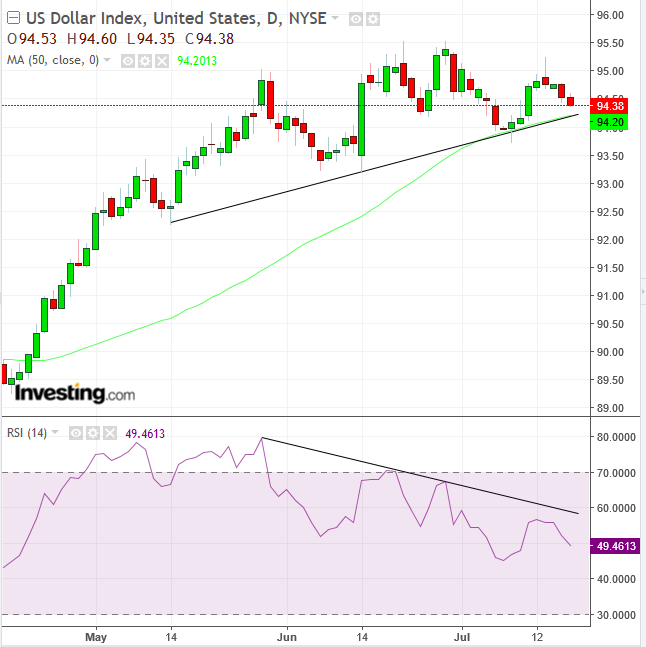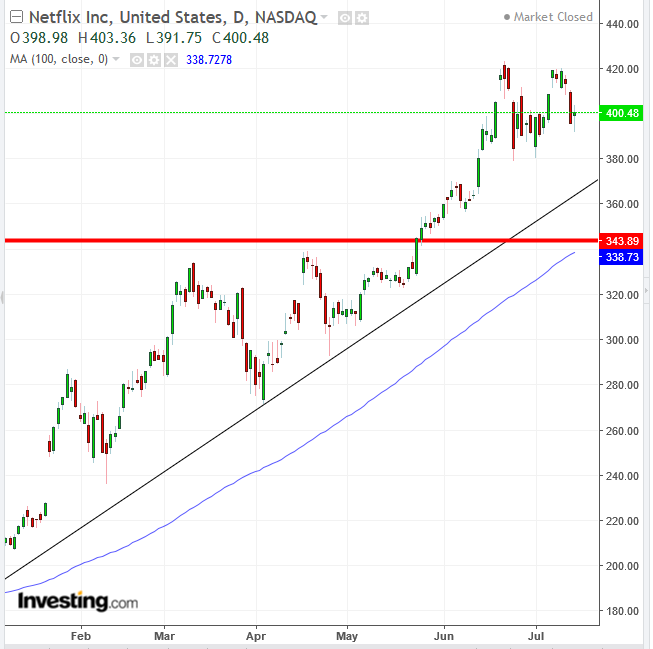- USD, Treasuries edge lower ahead of Powell testimony
-
European tech stocks slide alongside US futures
-
Underwhelming Netflix subscriber growth prompts 14 percent stock tumble in after hours trade, broader tech investment worries
-
WTI crude eases after steep plunge on reports of extra supply from both Saudi Arabia and the US
Key Events
Equities in Europe and futures on the S&P 500, Dow and NASDAQ 100 followed Asian stocks lower on Tuesday, as investors weighed mixed earnings reports from some US heavyweights including Netflix and Bank of America against a backdrop of ongoing trade jitters.
Corporate results so far have provided an uneven picture, making a rally in equities more challenging for traders who were hoping that solid company performance would offset persistent geopolitical uncertainty. Yesterday, Wall Street darling Netflix (NASDAQ:NFLX), whose high-flying shares reached an all time-high as recently as July 11, sorely disappointed, missing a key metric for the company's growth, new user estimates, which were off by 20 percent, sparking fears in Wall Street of a valuation bubble for the internet television giant.
Currently, US Treasuries and the dollar are sliding lower ahead of Fed Chairman Jerome Powell's semi-annual testimony to Congress; any cue from the Fed Chairman regarding forward monetary policy is set to be the key market mover this week, alongside earnings data.
However, the fact that both government bonds and the USD are losing ground today, for a second straight session, could underpin different drivers: if we consider that the greenback is usurping the status of global safe haven currency from the yen and the Swiss franc, one explanation could be that investor sentiment is shifting to risk-on. However, if that were the case, stocks would be moving higher and they're currently weak.
A second interpretation could, therefore, be more accurate: traders may be selling Treasuries since they expect Powell's signals will point to a hawkish stance by the Fed, based on the recent strong economic data and an underlying expectation that US growth is intact. This would warrant higher interest rates, in turn prompting higher yields and leading investors to rotate out of bonds and into equities. But then, why would the dollar be falling? Should it not strengthen on the positive outlook?
Maybe the Treasury selloff is driven by foreign investors, whose repatriation includes selling the greenback.

Technically, the USD is falling toward its uptrend line since May 14, which is “guarded” by the 50 DMA. Note, the MACD’s negative divergence, which is signaling prices may be heading lower.
Global Financial Affairs
This morning, the pan-European STOXX 600 slipped lower led by telecommunications and technology firms, which were weighed down by the painfully soft subscriber growth reported yesterday by Netflix.
Earlier, during the Asian session, Japan’s TOPIX bucked the regional downward trend and climbed 0.82 percent for a third straight day. The benchmark index was spared yesterday’s equity selloff, as it was closed for a holiday.
Hong Kong’s Hang Seng underperformed, dropping 1.22 percent, while China’s Shanghai Composite turned a 1.37 percent plunge into a more manageable 0.55 percent slide.
Why this discrepancy? Perhaps, the mainland index rebounded after reports that Chinese officials were confident the country's economy would reach their 6.5 percent target, despite trade war headwinds. Conversely, the offshore index may have been affected by warnings, from Hong Kong-based broker BOCI Securities, that China stands to suffer further trade tariff blows from the US.
The second reason mainland shares outperformed Hong Kong stocks may be that the former have been falling for three straight sessions, for an aggregate 1.36 percent setback, while the latter slipped into negative territory only today.
This morning’s selloff follows yesterday's US trade in which the NASDAQ 100 experienced a setback for the first time in three sessions. The tech index was dragged lower by a steep post-earnings call plunge in Netflix shares (as well as losses for Tesla (NASDAQ:TSLA), Hasbro (NASDAQ:HAS) and DISH Network Corporation (NASDAQ:DISH) shares.)

The stock dived 14 percent in after-hours trading. Technically, while it crossed below its uptrend line since the beginning if the year, it found demand above the preceding, April price peak, as well as by the 100 DMA.
Meanwhile, the S&P 500 meandered near the key 2,800 level. Here, losses in the Energy sector) offset gains in Financials that had been favored by upbeat results from the likes of Deutsche Bank (NYSE:DB), BlackRock (NYSE:BLK) and Bank of America (NYSE:BAC), which all beat estimates.

WTI crude plunged more than 4 percent intraday on Monday. The commodity settled with a 3.65 percent decline, after Saudi Arabia allegedly offered extra crude supplies to Asian buyers and US President Donald Trump reportedly was considering tapping into the nation’s emergency oil supply to cool mounting fuel prices, ahead of the crucial midterm election.
Technically, the double-digit fall, from $75 two weeks ago, is a correction within a rising trend, after prices reached a 40-month high. Today, the price ticked 0.2 percent higher in Europe's morning trade, coming back from a 0.45 percent decline.
Up Ahead
- Earnings season continues with reports due from:
-
Goldman Sachs (NYSE:GS) reports today before market open, with a $4.67 EPS forecast vs $3.95 for same quarter last year
-
Johnson & Johnson (NYSE:JNJ) reports today before market open, with a $2.06 EPS forecast, against $1.83 for the same quarter last year
-
Morgan Stanley (NYSE:MS) publishes results tomorrow before market open: its EPS forecast stands at $1.08, vs $0.87 for same quarter last year
-
American Express (NYSE:AXP) reports tomorrow after market close, with a $1.83 EPS forecast, against $1.47 for same quarter last year.
-
IBM (NYSE:IBM) is also due to report tomorrow after market close, with a $3.03 EPS forecast against $2.97 for the same quarter last year
-
Microsoft (NASDAQ:MSFT) is coming up on Thursday after market close, with a $.07 EPS forecast, vs $0.98 for same quarter last year
-
Fed’s Powell delivers the semi-annual Monetary Policy Report to a Senate committee on Tuesday and a House panel on Wednesday, and will answer lawmakers’ questions.
Market Moves
Stocks
-
The STOXX Europe 600 slipped 0.1 percent.
-
Futures on the S&P 500 fell 0.1 percent.
-
The MSCI All-Country World Index gained less than 0.05 percent.
-
The MSCI Emerging Market Index dropped 0.3 percent.
Currencies
-
The Dollar Index fell 0.13 percent for a two-day loss of 0.37 percent, to the lowest level since last Wednesday.
-
The euro gained 0.2 percent to $1.1732, the strongest level in a week.
-
The British pound climbed 0.1 percent to $1.325, the strongest in a week.
-
The Japanese yen edged 0.1 percent lower to 112.37 per dollar.
Bonds
-
The yield on 10-year Treasuries climbed less than one basis point to 2.86 percent, the highest level in more than two weeks.
-
Germany’s 10-year yield slipped less than one basis point to 0.36 percent.
-
Britain’s 10-year yield lost less than one basis point to 1.277 percent.
Commodities
-
The Bloomberg Commodity Index climbed 0.2 percent.
-
West Texas Intermediate crude slipped 0.5 percent to $67.74 a barrel, the lowest level in almost four weeks.
-
LME copper climbed 0.4 percent to $6,216.00 per metric ton.
-
Gold gained 0.2 percent to $1,243.28 an ounce.
